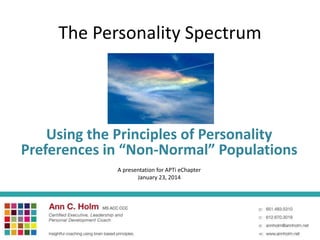
The Personality Spectrum: Using the Principles of Personality Preferences in “Non-normal” Populations
- 1. The Personality Spectrum Using the Principles of Personality Preferences in “Non-Normal” Populations A presentation for APTi eChapter January 23, 2014
- 2. What is Your Assessment Philosophy? Let’s take the quiz!
- 3. 1. Assessments need to be administered to the target audience only as outlined in the manual. ______1_________2____________3______________4.___________5_______ Strongly disagree Disagree Neutral Agree Strongly Agree
- 4. 2. An incomplete assessment is of no value. ______1_________2____________3______________4.___________5_______ Strongly disagree Disagree Neutral Agree Strongly Agree
- 5. 3. You should not take the principles and concepts from an assessment and create your own tool or screening. ______1_________2____________3______________4.___________5_______ Strongly disagree Disagree Neutral Agree Strongly Agree
- 6. 4. The most important conclusions from an assessment will not necessarily be based on it’s concrete findings. ______1_________2____________3______________4.___________5_______ Strongly disagree Disagree Neutral Agree Strongly Agree
- 7. 5. It is sometimes more desirable to work from a hypothesis rather than a final conclusion when using assessments. ______1_________2____________3______________4.___________5_______ Strongly disagree Disagree Neutral Agree Strongly Agree
- 8. 6. The interpretation and collaborative discussion that takes place after an assessment is the most important step of the process. ______1_________2____________3______________4.___________5_______ Strongly disagree Disagree Neutral Agree Strongly Agree
- 9. RESULTS! If you scored yourself high on questions 1,2,and 3, you tend to be an Assessment Purist. You place high value on sticking with the data based, researched results. If you scored yourself high on questions 4,5,and 6, you tend to be an Assessment Artist. You like to take the principles of the assessment and nuance them based on the situation.
- 10. Case Study #1 A 32 year old female was bitten by a mosquito and developed encephalitis, an inflammation of the brain. After her hospital stay, her residual problem was moderate memory loss. In trying to perform activities of daily living, her memory affected most outcomes. From schedules to “how to’s” to important tasks she needed to do, she was having difficulty due to her memory loss.
- 11. Her ENFP speech therapist suggested this as a memory strategy:
- 12. But she wanted this “because the post-it notes look messy and clutter up my kitchen” : What do you think her type might have been?
- 13. What is an “off-label” use of something? In medical parlance, off-label use is using a drug that in a way that isn’t specifically indicated by the manufacturer or is used in a population that the drug was not intended for.
- 14. Case study #2 24 year old engineer with known diagnosis of Asperger’s Syndrome. This is one population that is not indicated as an appropriate use of the MBTI. Going “off label”, the client took the MBTI Form M and type verified ISTJ. In our discussion, among other things he learned that: • ISTJ’s have a natural strength for details (normalizing some of the behavior associated with this disorder). • ISTJs learn best by practice. “I practice certain social things and I know that’s how I get better at it.” • There is a natural preference for structure in ISTJs. Through writing with the non-dominant hand exercise, he learned that others might prefer less structure. Question: What did the client gain by taking the MBTI? What were the drawbacks? What else might he learn about himself?
- 15. When perception and judgment are out of balance, there is the potential for chaos (too much stimuli/too many thoughts) or rigidity (being closed to new information). When balance and integration are present, the mind flows like a river. Taken from The Mindful Therapist by Daniel J. Siegel (2010)
- 16. Case Study #3 52 year old rabbinic cantor who type verified INFP. He has wondered if he might have ADHD as he reports difficulty staying focused, on time, and organized. Upon seeing a doctor a couple of years ago, he was prescribed Adderall and indeed his focus was improved. However, he also found that his creativity was compromised, so he stopped taking the medication. As he learned more about his type, he discovered the impact of having a auxiliary extraverted intuition and also a preference for “P”. What do you think he could do differently to improve attention and focus without relying on medication? How can he help himself bring perception and judgment into balance?
- 17. Top 3 Strategies that helped the Cantor: 1. Simplify his external strategy to stay organized. Having too many files, labels, systems and sub-systems were created in the moment by extraverted intuition but difficult to trace after the fact. 2. Decrease visual clutter in his office and rearrange his room to encourage an atmosphere conducive to focusing. 3. Use a timer to stay ensure that he stayed on task and did not switch over to something else.
- 18. Ann’s List of Off-Label Guidelines Do • Use the MBTI as a way to explore the parameters of type. Stay flexible! • Be aware of limitations of using actual MBTI (language limitations, age, disability) • Use other tools and resources to identify type • Make your own screening tool as needed • Use actual or hypothesized preferences to create effective strategies to meet goals • Use type preferences to change the environment for a desirable outcome • Involve family if needed to discuss preferences • Collaborate and share information with physicians Avoid • Pushing toward a final type verification if it isn’t forthcoming. Stay curious! • Struggling too much to identify what is type-related and what is not. Behavior is behavior so strategize with the assumption that you are addressing a behavior. • Relying on one instrument if something else works better • Getting into type arguments. Sometimes incorporating the concepts of type take time. It’s a process!
- 19. Ann's Blog @ MN Coaches “Mind Matters”: http://minnesotacoaches.org/blog/ Ann's Blog @ International Coaching Federation: http://icfheadquarters.blogspot.com/
- 20. Contact Information: Email: Annholm@Annholm.net Websites: Annholm.net QueenAnntics.net Annholm.net AnnholmNet Linkedin.com/in/annholmnet
